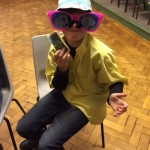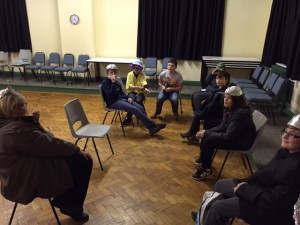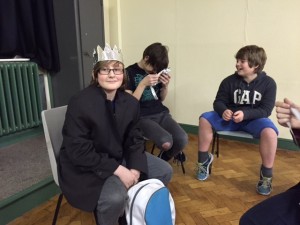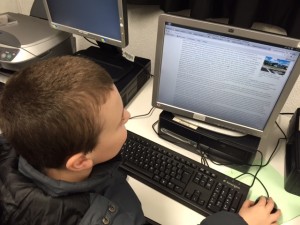Development of the game
This game was developed by fsfe-mcr, along with the Manchester open rights group and bitcoin Manchester in 2014. It was initially played at crypto-parties in Madlab.
Learning outcomes

The game teaches the basic principles of asymmetric encryption in a fun way; that is a public and private key. Additional topics such as key servers, the web of trust and “back-door” snooping are also touched on.
The fancy dress element provides a way for participants to “step outside” of their day-to-day life for a western citizen to discuss the broader social context of encryption, so “who is watching” and “why keep secrets.”
The game was originally designed to be played as part of a two hour event for adults, which would cover using email encryption tools such as gpg, enigmail, hard disk and chat encryption; the learning outcomes were more technical. In this context, however, it is only the concepts are explained.
What you need
Your kids will be divided into three groups, and each group needs something a little different.
For the sender and recipient

These are the participants who will send the message.
- Two sets of “Keyed Alike” locks, these are sets of padlocks which have a single key.
- Two lockable items, such as child’s diary or a box that can be padlocked – to put messages inside
- Two pens
For the Transmitters

This group of people represent the servers, routers, wireless signals and cables through which the message is sent. We got the kids to come up with the different types of tech that an email might pass through.
- Tinfoil to make tinfoil hats (with antenna etc)
- You can put as much or a little effort into this as you like, you could give them names of different transmitter devices.
For the snoopers

These are the people who will try to intercept the message and find out the contents. If you have a lot of kids, they can be divided into snoopers (who sit/stand with the transmitters) and third party snoopers, who are free to move about.
- Suspicious fancy dress: funny disguises such as glasses and head scarves, moustaches, big hats.
- Powerful fancy dress: military style wear, suits and briefcases, etc.
- Marketing/sales creep fancy dress: Hawaiian shirts and fistfuls of cash
How to play
Setting up the game

- Assign one person to be the sender and another to be the recipient.
- Assign several people to be snoopers – give them items of fancy dress / disguises to wear.
- Line up the transmitters, and a few of the snoopers, between the sender and recipient
- Mix a few of the snoopers into the line
- Leave the rest of the snoopers free to move about as third party snoopers
- If you have a lot of participants you can make a large circle rather than a line.
Distributing the locks and keys
- Give the recipient the locks and key
- Ask them to distribute the locks around the room, putting them in easy to find places (you can later explain about key-servers)
- Explain that the locks are all identical
- Ask them to keep the key safe (on a ribbon around their neck for example)
- Repeat the example with the senders locks and key
Sending a mail: the locks and keys principle.
- Ask the sender to write the message in the diary
- Ask the sender to go and get one of the recipients locks and lock up the diary.
- Ask the sender to pass the locked diary to the first person in the line of transmitters
- Ask each transmitter/snooper to pass the diary along, can they see the message (no)
- When the recipient gets the diary, ask them to try and open it without the key (they can’t)
- Ask them to open it with their key (they can) and read the message
Replying to the mail: third party snoopers v transmitters

- Ask the recipient to write a reply in the diary
- Ask the recipient to go and get one of the senders locks, to lock the diary
- Ask the recipient to pass the locked diary to the first person in the line of transmitters
- Ask each transmitter/snooper to pass the diary along, can they see the message (no)
- Ask the third party snoopers to look over the shoulders of the transmitters, can they see the message (no)
- When the sender gets the diary, ask them to try and open it without the key (they can’t)
- Ask them to open it with their key (they can) and read the message
Sending another mail: third party snoopers with a back door
- Ask one or two of the third party snoopers to stand behind the sender.
- Ask the sender to write the message in the diary – can the third party snoopers see it (yes)
- Get them to tell a friend or sell the info for money
- Ask the sender to go and get one of the recipients locks and lock up the diary
- Ask the sender to pass the locked diary to the first person in the line of transmitters
- Ask each transmitter/snooper to pass the diary along, can they see the message (no)
- Can the third party snoopers tell them what it says (yes)
- Could the third party snoopers tell each other what it says (yes)
- When the recipient gets the diary, ask them to try and open it without the key (they can’t)
- Ask them to open it with their key (they can) and read the message
Breakout task
“Woods for trees”

One common objection to encrypting is that “but I don’t have anything to hide.” This is quick task to show that when everyone encrypts the people who seriously need to encrypt are safer. Get everyone to stand about in a random huddle, and get two kids in the middle to join hands and talk to each other: they represent an encrypted conversation. Ask “how easy is it to spot them?” Next, get everyone to join hands all crisis-crossed so the group makes one big knot, and they all talk at once: ask “how easy is it to spot the original encrypted conversation now?” (not very easy).
Researching related topics
Before we started the game, we got the kids to research Edward Snowdon (they did not know who he was at first). We asked them to come up with
- one basic fact each
- a pair of contrasting arguments related to him each
and then we discussed them together. We introduced email encryption by explaining that it was used by Snowdon to communicate with the journalists safely.